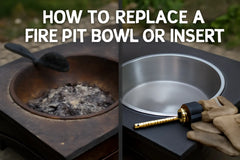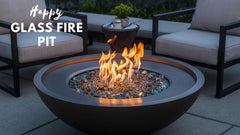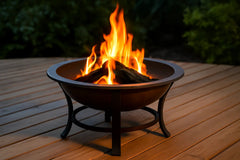Tabletop Patio Heaters: Small Space Heaters
Exterior areas have been made to form an extension of our houses. Small gardens, balconies and patios provide a space to relax, eat or entertain. However, it may not be easy to enjoy these places during cooler evenings. Tabletop patio heaters can be useful in this case. Small, sleek, efficient and warm without crowding the small areas.
Tabletop models are small, compact, and designed to be portable and comfortable within a close range. Unlike tall freestanding heaters, which are best used in urban areas with small parties.

Which fuel type is best for a tabletop patio heater?
The best fuel type depends on your needs:
| Fuel Type | Pros | Cons | Best For |
|---|---|---|---|
| Propane | High heat output, portable, no outlet needed | Requires fuel replacement, uses fossil fuel | Maximum warmth outdoors |
| Electric | Convenient, no refueling, safe indoors | Needs outlet, limited placement | Continuous heating near power source |
| Ethanol | Smoke-free flame, decorative, eco-friendly | Lower heat output, ongoing fuel cost | Ambience and style in small patios |
What is Special about Tabletop Patio Heaters?
Compared to standard outdoor heaters, tabletop patio heaters are very small. They usually measure about 3 feet high, and weigh less than 20 pounds, but resemble fancy lamps. They generate a strong heat within a smaller area despite being very small, usually within a radius of 5 to 7 feet.
They are mainly used to establish a heating area locally, unlike bigger freestanding units which are used to heat an entire patio. This is why they are ideal when two people are on a dinner date or friends are playing on a balcony. Learn More about the best Patio Heaters in 2025.
Styles of Tabletop Patio Heater
Propane Tabletop Heaters
Propane models are very popular. They burn small canisters of gas resembling camping stoves, so they can be taken anywhere and do not require power outlets. They provide high intensity heat, usually 8,000 to 12,000 BTUs. Propane heaters are generally the best option in small outdoor spaces to provide the greatest amount of warmth.
Electric Tabletop Heaters
Electric heaters are easy to use and plug and play. They usually operate quartz or halogen lamps and emit no radiation in their operation. They are practical because they do not need the replacement of fuel. But this requires them to have access to a power outlet and this can restrict their placement.
Ethanol Tabletop Heaters
Ethanol heaters focus on the atmosphere as well as soft heat. They produce a simulated fire without smoke and smelly fumes. They produce less heat, between 2,000 and 6,000 BTUs, although they add a comfortable glow to the atmosphere. They can be used on very small patios or to decorate.
Pros of Tabletop Patio Heaters
Space Efficiency
Even small outdoor spaces can be too limited to include full-sized heaters. Tabletop designs can easily fit on a dining or side table without crowding the table. They help keep the patio useful and also warm.
Portability
Tabletop heaters are easy to transport around and are lightweight and compact. Instead, you can transfer them off the balcony and into the garden or even take them camping. This allows them to be used as all-purpose investments.
Cost-Effective Heating
Tabletop heaters are cheaper than tall models that are free-standing. They need less fuel or electricity thus reducing the cost of running them whilst offering good heating. They are affordable enough to the budget conscious.
Decorative Appeal
Tabletop heaters of today are aesthetically designed. Outdoor furniture is easily blended with finishes of stainless steel, bronze, and matte. Many are styled like lanterns or small fire pits, and thus are as chic as they are convenient.
Tabletop Patio Heater Best Uses
These heaters are small and therefore can be used in any environment.
They can be used on apartment balconies where there is less space and comfort is required. Putting one in the middle of a dining table keeps visitors warm as they have meals outside. They also do a great job of extending the outdoor life into spring and fall when the evenings are cool. In small meetings, they contribute to keeping the place warm without having to carry the huge heaters.
Safety Considerations
Tabletop heaters are safe, but the user should be cautious. They should always be set on a level, steady surface because they can be tipped over. To avoid the risks associated with carbon monoxide, propane and ethanol models must be utilized in highly ventilated outdoor locations. Keep heaters out of the way of tableclothes, cushions or plants to prevent fire. Tipped over automatic shut-off systems are now a feature of many models and something to look at when buying.
Heat Output Comparison
Tabletop heaters are small in size, but they perform well. The warmest propane models are 8,000 to 12,000 BTUs. Electric units deliver between 500 and 1,500 watts, and that is sufficient to serve small parties or a small patio. Ambiance models would be better on ethanol with 2,000 to 6,000 BTUs. All types have various needs propane, heat, electric, convenience, and ethanol, atmosphere.
The Trend in Designing Tabletop Heaters
The importance of design has become equal to the functionality of contemporary tabletop heaters. Manufacturers have now started to make models which combine decorative features with heating. Popular trends include glass flame chambers, smooth powder coat finishes and built in LED lights. Other heaters will mimic the appearance of a decorative lamp or lantern and become a statement piece instead of a strictly utilitarian object.
Eco-Friendly Considerations
Green is a phenomenon in outdoor heating. Propane heaters are very powerful but dependent on fossil fuels. When heated by renewable energy sources, electric heaters can be more environmentally friendly. Plant-based biofuels are also turned into heaters that are not polluting the environment, such as ethanol heaters. The selection of the type will frequently require a trade-off between the heat needs and the environment.
Maximising Efficiency
Heater placement is strategic and helps increase heater performance. Locating a tabletop heater in a wind-sheltered area or close to reflective walls is a good idea to evenly spread the heat. In the case of electric heaters, halogen bulbs that use less energy can be used without decreased performance. Windbreaks, screens, or patio enclosures are also a good way to trap in warmth and get the most out of your heater.
Maintenance and Care
Tabletop heaters also require proper maintenance to be effective. Propane burners must be inspected and swept clean. Electric heaters have the advantage of dust removal and inspection of heating components. Ethanol models must have fuel chambers cleaned periodically to stop the accumulation of a residue. Covering heaters during the winter months keeps them out of the weather and helps to extend their life span. Regular inspections guarantee safety as well as uniform performance.
Conclusion
Tabletop patio heaters are convenient and appealing to use in small areas. Small but mighty, they enable people with homes and apartments to enjoy the outdoors all year round. As there are propane, electric and ethanol models, users can opt to go with ultimate heat, environment-friendly operation or ornamental effect.
They are not just a heater but a style of life with their affordability, convenience, and design. With the right tabletop heater and implementing it properly, you can turn a balcony, patio, or garden into a cozy and inviting space even on cold nights.
FAQs
Q1. What is the difference between a tabletop patio heater and a freestanding patio heater?
A tabletop patio heater is compact, lightweight, and designed to heat a small, localized area such as a dining table or balcony. In contrast, a freestanding patio heater is larger, heavier, and powerful enough to warm an entire patio or backyard.
Q2.How much heat does a tabletop patio heater produce?
Most tabletop propane heaters generate between 8,000 and 12,000 BTUs, while electric models produce 500–1,500 watts, and ethanol heaters range from 2,000 to 6,000 BTUs. This is sufficient for close-range warmth in small gatherings.
Q3. Are tabletop patio heaters safe to use?
Yes, tabletop patio heaters are generally safe when used properly. Many models feature automatic tip-over shut-off systems. However, propane and ethanol heaters must always be used in well-ventilated outdoor areas to prevent carbon monoxide buildup.
Q4. Which fuel type is best for a tabletop patio heater?
-
Propane: Best for portability and maximum heat.
-
Electric: Best for convenience and continuous use near outlets.
-
Ethanol: Best for ambiance and decorative purposes.
The choice depends on your priorities—heat output, convenience, or aesthetics.
Q5. Can tabletop patio heaters be used indoors?
No. Propane and ethanol models should never be used indoors due to carbon monoxide risks. Only electric tabletop heaters are safe for indoor use, provided they meet safety certifications.
Q6. How do I maintain a tabletop patio heater?
Maintenance involves cleaning propane burners, removing dust from electric elements, and clearing residue from ethanol fuel chambers. Covering the heater when not in use also helps extend its lifespan and keep it weather-protected.






